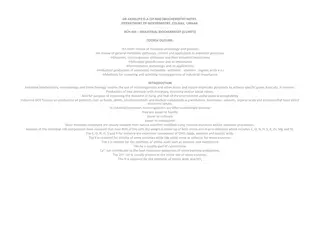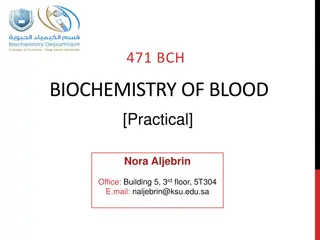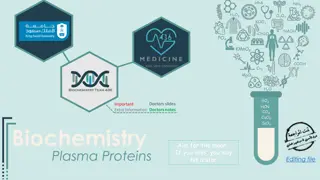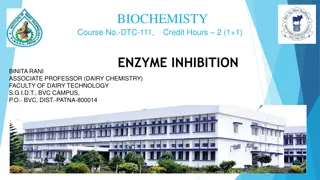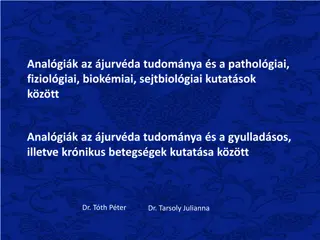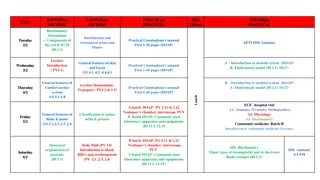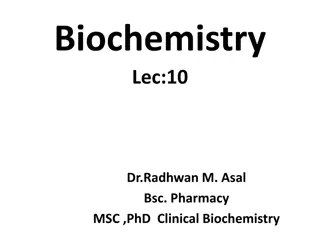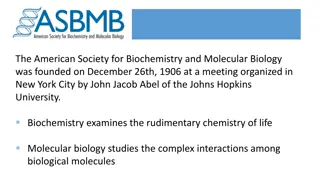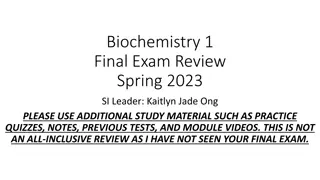Biochemistry
This content provides insights into blood glucose, diabetes mellitus, common signs, symptoms, lab results, and comparisons between Type 1 and Type 2 diabetes. It also covers laboratory tests for glucose, criteria for diagnosing diabetes mellitus, and categories of increased risk.
Download Presentation

Please find below an Image/Link to download the presentation.
The content on the website is provided AS IS for your information and personal use only. It may not be sold, licensed, or shared on other websites without obtaining consent from the author.If you encounter any issues during the download, it is possible that the publisher has removed the file from their server.
You are allowed to download the files provided on this website for personal or commercial use, subject to the condition that they are used lawfully. All files are the property of their respective owners.
The content on the website is provided AS IS for your information and personal use only. It may not be sold, licensed, or shared on other websites without obtaining consent from the author.
E N D
Presentation Transcript
HbA NH2 H2O2 Cl2O7 KClO3 NAOH CH2O PO4 KMnO4 M E D I C I N E COOH KING SAUD UNIVERSITY Co2 MgCl2 H2O SO2 Doctors slides Important ExtraInformation Numbers Doctors notes HCN CCl4 CuCl2 SiCl4 Editing file Editing file Biochemistry A strong positive self-image is the best possible preparation for success. - Joyce brothers ENDOCRINE Block Practical Sessions
Outline This file contains one lecture. This work is done by students, so if there are any mistakes please inform us . Lecture title : Blood glucose
Blood Glucose Diabetes Mellitus: Common signs, symptoms and Lab results: Polyuria? &? Glycosuria Hyperglycemia Polydipsia Polyphagia
Comparison of Type 1 & Type 2 DM Numbers here are important Type 1 Diabetes Type 2 Diabetes Age of onset Usually during childhood or puberty. Frequently after age 35 Prevalence % 10% of diagnosed diabetics. 90% of diagnosed diabetics. Insulin resistance combined with inability of cells to produce appropriate quantities of insulin. Defect or Deficiency cells are destroyed, eliminating insulin production . Ketoacidosis1 Common. rare High early in disease; low in disease of long duration. Plasma Insulin Low to absent . 1.Diet and exercise . 2. Oral hypoglycemic drugs. 3. +/- insulin, required ( not always depend on his/her condition) Treatment Insulin is always necessary. 1-Diabetic ketoacidosis is a serious complication of diabetes that occurs when your body produces high levels of blood acids called ketones. The condition develops when your body can't produce enough insulin.
Laboratory Tests For Glucose Glucose laboratory tests Is a measurement of plasma glucose after 12 hours of fasting (no caloric intake). Normal blood glucose range: 3.9 5.6 mmol/L (70 100 mg/dL ). 1. Fasting plasma glucose : 2. Oral Glucose tolerance Test (OGTT) & 2-hour post- prandial test Serial measurement of plasma glucose before and after a specific amount of glucose given orally (75g glucose). Normal level: ( < 7.8 mmol\L ). 3. HEMOGLOBIN A1C measurement : used to estimate glycemic control in the last 1-2 months & Recommended for the detection of type 2 DM. Normal level : 4 5.6 % . 4. Random Plasma Glucose Level : ______________ Hemoglobin A1C (A1C ) is produced due to non-enzymatic glycosylation of hemoglobin. It is used to estimate glycemic control in the last 1-2 months. 5. HEMOGLOBIN A1C : Recommended for the detection of type 2 Diabetes Mellitus. HBA1C and fasting plasma glucose are effective in diagnosing diabetes. Cut-off point of 6.5 % is used to diagnose diabetes. Q: When does someone is said to have an impaired glucose tolerance (Pre-diabetes state) ? When fasting plasma glucose OR 2-hour postprandial glucose level is above normal but below diabetic level.
Criteria For Diagnosis of Diabetes Mellitus Categories Of Increased Risk of DM & Diagnosis Of DM Test performed/ - Normal Pre-diabetes Diabetes FPG or IFG 1 : 100 - 125 mg\dl 5.6 - 6.9 mmol/L (fasting= No caloric intake for at least 8hs) 126 mg\dl and over 7 mmol/L and over Fasting Plasma Glucose (FPG) Less than 100 mg/dl OGGT or IGT2 [ 2 : 140 199 mg\dl 7.8 11.0 mmol/L [ 2 hours post glucose on the 75-g OGTT Less than 140 mg/dl 200 mg\dl and over 11.1 mmol/L and over HA1C Less than 5.7% 5.7% - 6.4 % 6.5% and over 200 mg/dl and over 11.1 mmol/L and over Random Plasma Glucose Level _____ _____ + signs and symptoms of hyperglycemia or hyperglycemic crisis Ketone Bodies: They produce by the liver and utilized for energy production by peripheral tissues . ( common in type I DM) 1- IFG: impaired fasting glucose 2- IGT: impaired glucose tolerance 1. Acetone (exhaled by lungs, gives characteristic smell in diabetic ketoacidosis patients). 2. Acetoacetate. 3. -Hydroxybutyrate. 4. Produced by the liver and utilized for energy production by peripheral tissues.
Urinalysis Using Dipstick Note here is important Principle: Dipsticks are plastic strips impregnated with chemical reagents which react with specific substances in the urine to produce color-coded visual results. They provide quick determination of pH, protein, glucose and ketones. The depth of color produced is proportional to the conc. of the substance in urine. Color controls are provided against which the actual color produced by the urine sample can be compared You must know how to compare color changes with the control charts. The reaction times of the impregnated chemicals are standardized. Procedure : 1. Dip the dipstick in the urine sample provided. 2. Remove it immediately. 3. Wipe off excess urine, Keep strip horizontally. 4. Read the color produced within 30- 60 seconds or immediately Do not read it after 60 sec. Color changes after 60 sec . Are of no significance. 5. Compare color changes with the control charts provided.
Principle of urine strep The urine strip are impregnated with a variety of reagents that react with substances in the urine to produce color. The intensity of color is proportional to concentration of the substance being detected. 1- Glucose : glucose oxidase enzyme on the strip react with glucose in urine to produce gluconic acid and hydrogen peroxide that reacts with peroxidase to produce bluish-green, greenish-brown, dark brown color. 2-Protein: Tetrabromophenol reacts with proteins to produce yellow-green, green, blue- green color. 3-Ketones: sodium nitroprusside react with ketones to produce pink , pink-purple color. 4-PH: bromothymol and methyl red indicators change color due to acidity or alkalinity of urine.
Changes In Urine Dipstick Observed In Diabetic Patients And Their Interpretation Extra : Physical examination *These results of diabetes patient* Parameter Results Interpretation reasons Appearance --------- Clear Normal Color Colorless Polyuria Diabetes Diabetic ketoacidosis Starvation anxiety Odor Fruity (in case of Dka1 ) Ketogenesis Chemical parameters IMPORTANT Test Results Interpretation reasons diabetes mellitus Fanconi Syndrome Urine Glucose + Glucosuria You might get a picture similar to this in the exam , and be asked to fill the schedule based on comparing the urine dipstick test of patient with color control. Chronic kidney disease Diabetes May be present (in case of nephropathy ) Urine Protein Proteinuria Diabetic ketoacidosis Starvation + Urine Ketones Ketogenesis/ Ketonuria (In case of DKA) 1-Diabetic ketoacidosis Uncontrolled diabetes dehydration Urine PH Acidic (in DKA) > 6 Aciduria
Measurement of Blood Glucose Level Using Glucometer Note here is important Instructions: 1.Attach the test tip to the glucometer as shown. 2.The meter will read OK indicating that it works properly. 3.Disinfect your fingertip using an alcohol swab. 4.Let it dry. BIOHAZARD! The lancet in the lancing device is for single use only. Discard it after use .* don t reuse it again* 5. Prick the finger using the lancing device. 6.Draw up blood until the glucometer beeps. 7.Wait for 10 seconds until results are displayed. 8.Results can be read as mmol/L or mg/dL. 9.Interpret your results.
Benefits of Self-monitoring of Blood Glucose Level IMPORTANT It facilitates patient education about diabetes and its management by giving them more self- care responsibilities . It allows patients to detect their blood glucose levels without visiting a clinic . It helps patients to immediately confirm hypo or hyperglycemia to avoid complications. It helps to promote wellbeing of patients .
Test Your Self Q1) What is your Interpretation of the patient s results : Patient A Patient B Patient C FPG 12 6.5 mmol/L 1 10.2 mmol/L mmol/L Hb A1C 10% 6% 9% Serum ketones 50 Negative Negative mg/dl Urine Ketones +++ Negative Negative Urine Glucose +++ Negative ++ Protein +++ Negative +++ pH 7.0 7.3 7.2
Test Your Self The answer: - Patient A : - Patient B : - Patient C: 1. Very High FPG Hyperglycemia and this indicates that the patient is diabetic 2. HbA1C is raised which shows his blood glucose level was uncontrolled for the last 2 months, this confirms diabetes. 3. Ketonemia and ketonuria indicate that the patient has DKA. 4. Glucosuria indicates the glucose filtration level is abnormally higher than the kidney threshold. 5. The presence of protein in urine proteinuria is caused by nephropathy (complication of uncontrolled DM). Low pH of urine Acidic urine indicates metabolic acidosis due to increase production of ketone bodies The diagnosis is: Diabetes ketoacidosis. 1. High FPG Hyperglycemia and this indicates that the patient is diabetic 2. HbA1C is raised and shows his blood glucose level was uncontrolled high for the last 2 months. 3. The presence of glucose in urine Glucosuria which this also indicates the patient has high blood glucose level. 4. And the glucose filtration level is abnormally higher than the kidney threshold. 1. FPG is higher than normal BUT not diabetic Pre- diabetic and shows Increase risk of diabetes. 2. HbA1C is raised and shows his blood glucose level was uncontrolled high for the last 2 months. The diagnosis is: Impaired Fasting Glucose PreDiabetes The diagnosis is: Diabetes Mellitus with nephropathy .
Test Your Self Q1) A 50 year male came to the clinic with symptoms of dehydration, polyuria and polydipsia. A urine sample was taken from him with the following results: Observation Comment Protein +++ Proteinuria Glucose +++ Glucosuria Ketone bodies - Normal PH 6 Acidic Q) What is the most likely diagnosis ? Diabetes mellitus. Q) What is the reason of presence of protein in the urine sample ? Nephropathy. N.B: You might be asked to fill the comment column.
Test Your Self Q1) A known diabetic was presented to the emergency room with symptom of confusion, weakness, fruity breath, nausea and vomiting, the picture showes the results of his urine dipstick test: Observation Comment Colorless Polyuria Color Fruity Ketones Odor - Normal Protein +++ Glucosuria Glucose +++ Ketonuria Ketone bodies 6 Acidic PH Q) What is your most likely diagnosis ? Diabetic ketoacidosis. Q) Name the three molecules of ketone bodies ? 1. Acetoacetate . 2. Acetone . 3. -Hydroxybutyrate.
Test Your Self Q) 60 year old female presented with polyphagia, fatigue and blurred vision. She is retired since 13 years staying at home most of the time. Despite losing weight, her BMI is 33. She mentioned that she had to wake up during the night to urinate in the pas 3 weeks. She has no family history of diabetes. The general practitioner ordered a blood glucose tests and the results were as the following: Result Normal Range 231 mg\dl (12.8 mmol\L) < 140 mg\ dl < 7.8 mmol\L OGTT HA1c 7.1 % 4 5.6 % Q3) Name two complications associated with her situation ? Q1) What is the most likely diagnosis ? 1.Retinopathy. Diabetes mellitus type 2 2.Neuropathy. Q2) What are the factors which predisposed her to such a condition ? Q4) What is the main underlying cause of her disease ? 1-Obesity. 2- Sedentary life style. 3- Aging . Insulin resistance. ..
THANK YOU FOR CHECKING OUR WORK TEAM LEADERS PLEASE CONTACT US IF YOU HAVE ANY ISSUE Mohammad Almutlaq Razan Alotaibi



